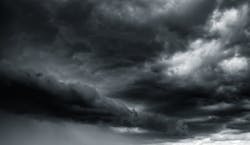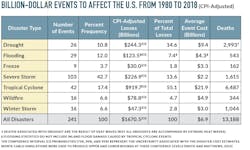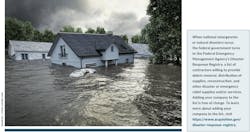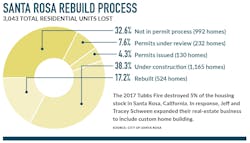Storm Surge
Sometimes it feels like as soon as we get through a storm or natural event, it’s immediately followed by another. Early in July, California was hit with two earthquakes, and Hurricane Barry made landfall in Louisiana. In Chicago, we spent May dealing with downpours, ending the month with 21 days of rain and a record-setting 8.25 inches of precipitation—many Midwestern rivers swelled past capacity, flooding the surrounding homes and farms.
In 2018 alone, the country experienced 14 billion-dollar disaster events: two tropical cyclones, eight severe storms, two winter storms, drought, and wildfires.“Every year we hear what the seasonal forecasts are [for hurricanes and other extreme weather]—above average, standard, or below average,” says Dr. Rick Knabb, on-air hurricane expert and tropical program manager for The Weather Channel. “What people don’t tend to realize is that although the frequency of storms may be down at times, that doesn’t mean there will be less damage.”
This steady uptick in damaging weather means an increase in damaged (or fully destroyed) homes. It’s a homeowner’s worst nightmare, but for remodelers, it’s an opportunity both to use their expertise to help struggling communities and to grow their companies’ client bases.
Regardless of the type of severe weather, restoration work covers the same basic steps: assess the damage, clear the debris, and begin to rebuild. We spoke to industry pros and weather experts across the country about severe weather affecting the remodeling and building industries, and what the future—of the industry, but also of the planet—may look like if the severity continues.
The Data
The National Oceanic and Atmospheric Association’s National Centers for Environmental Information (NCEI) is responsible for tracking U.S. weather and climate effects. According to NCEI research, 2016-2018 were historic years in that 45 separate weather events occurred, each causing more than $1 billion in damage. This is a three-year average of 15 weather disaster events per year, the highest on record and well above the annual average of 6.2 events per year from 1980-2018.
The damage potential has also increased in the last several decades, due to growing populations and material wealth, and complicated even further by the fact that many major cities sit in vulnerable areas (like coasts and river floodplains), whose building codes may cover the bare minimum necessary for safety, or may not be updated at all.
“Remodeling or rebuilding is a really good time to build back, better than the home was before,” Knabb says. “People realize they need to do something to make their homes stronger, so when they have the money to remodel, that’s the time to build it better. One thing we do in this country is we keep building homes back to the way it was in the first place, and we need to—and can—do much better.”
The type of disaster also affects whose businesses take the hit: builders or remodelers. The wildfires sweeping across California and the Pacific Northwest, for example, leave virtually nothing in their path save for smoke, ash, and displaced homeowners. If the housing stock burns to the ground or, in the case of a hurricane or tornado, is decimated by powerful winds, there are no homes to remodel.
Changes in weather patterns also affect building plans and timelines. Take the 2019 Model ReModel West home in Flagstaff, Arizona: When lumber was delivered to the site in late May, half an inch of snow quickly covered it. On average, the latest snow in the Flagstaff area falls in late April, nearly a full month earlier. The Owens Construction team manning the project had to adjust their timeline, and may face a similar dilemma in coming months as the yearly heavy rains hit the area in late summer and fall.
The Insights
Talking about severe weather and climate shift doesn’t have to be all doom and gloom. Even if we can’t drastically change the weather patterns right now, you can protect your company, and your clients’ interests with a little bit of foresight.
Anthony Worrall is the president of Reynolds Restoration in Pennsylvania, a company with 15 years of experience in disaster restoration. He says that when severe weather hits the area, the company feels it heavily in the availability of subs.
By the end of May, for instance, there had already been 28 tornadoes in Pennsylvania—according to NOAA data, the state typically averages 16 per year. “When there’s damage to roofs and siding, on 40-60 structures in the same small area, the subs also get hit with a ton of work, and it’s hard to get everyone committed to a single schedule for your jobs,” he says. “You only have so many employees and so much equipment, so you have to prioritize and help where you can. But that means not taking on every client that needs help.”
Worrall notes that a big obstacle with restoration work comes when it floods. “Residential flooding is not covered by a typical homeowners policy,” he says, “so usually we’re the bearer of bad news to a policyholder. And, if it is covered, it’s a small piece of it—$5K or $10K.” In those situations, he says, homeowners usually choose to dry out their space, repair the most damaged parts, and save the remainder for another remodel down the road.
“When you sell a standard kitchen remodel, you’re working with clients who have done their research for months. By the time they talk to you, they have a good idea of what they want,” Worrall says. “With fire or flood or other damage, they weren’t even thinking about that the day before it hit. The rollercoaster of emotions that the client goes through on a restoration project versus a remodel is very different.”
The Impact
Remodelers are used to seasonal fluctuations, and that carries over into storm damage restoration work as well. “A storm hits, you’ve got more work than you can fathom, and then once the dust settles, you’re back to slow,” Worrall says. “It helps to have other specialties within your company to pad the slower restoration times.”
Jeff Schween knows this well: He and his wife and business partner Tracey worked as real-estate agents for 16 years before the 2017 Tubbs Fire destroyed more than 5,000 homes over a three-week period in Sonoma County, Calif. “People we loved lost a lot to that fire, and we needed to find a way to help,” Schween says. They decided to partner with a local architect to open Santa Rosa Fine Homes, which organizes groups of homeowners in a close geographical location to build in a sequential time frame. This strategy allows the Schweens to give homeowners an average savings of 20-30% more than other builders in the area, according to Schween. Not only are they now equipped to help homeowners who choose to rebuild, but also those who would like to sell their lot and work to find a new, already-existing home elsewhere.
The Future
With hurricanes, in addition to the high winds, you’re facing the added bonus of torrential, days-long downpours. “It’s difficult to identify if the numbers and strengths of these hurricanes are increasing,” says Knabb, “but I am noticing that the water impacts from tropical storms and hurricanes are getting worse. The average speed of hurricanes is slowing down, but that means a worsened water impact.” And on top of it, he continues, there are more people living in the coastal regions, so there are more homes and businesses to flood. Any sea level rise that has already happened and that occurs from this point forward will continue to make coastal storm surges worse.
“The sizes of the storms have led to a slight increase in our storm restoration work in the past five to 10 years,” says Matthew McDaniel, marketing director for Hoffman Weber Construction in Minneapolis.
McDaniel notes that now and in coming years, technology will continue to change the game for restoration work and for remodeling overall. “We’re now using automated drone systems to inspect roofs, which can produce accurate reports showing damage at the granular level,” he says. “In commercial situations, for example, we can perform an inspection before a storm and date the condition, then overlay the data after a storm to show evidence of hail hits that occurred during the most recent storm.”
Natural disasters will continue, but remodelers can be part of the solution by helping homeowners recover from or prepare for the next big surge.




